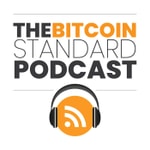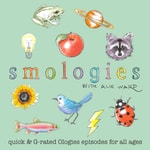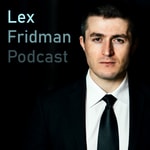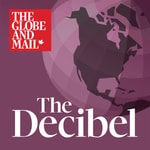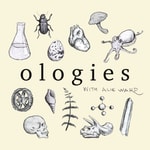Big Biology – Détails, épisodes et analyse
Détails du podcast
Informations techniques et générales issues du flux RSS du podcast.
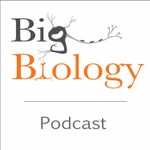
Big Biology
BigBiology
Fréquence : 1 épisode/16j. Total Éps: 159

bigbiology.substack.com
Classements récents
Dernières positions dans les classements Apple Podcasts et Spotify.
Apple Podcasts
Aucun classement récent disponible
Spotify
Aucun classement récent disponible
Liens partagés entre épisodes et podcasts
Liens présents dans les descriptions d'épisodes et autres podcasts les utilisant également.
See all- http://www.zapsplat.com/
124 partages
- https://www.bigbiology.org/
45 partages
- https://twitter.com/WalterIsaacson
11 partages
- https://twitter.com/GSI_Exeter
4 partages
- https://twitter.com/KevinJGaston
2 partages
- https://www.patreon.com/bigbio
12 partages
- http://patreon.com/bigbio
1 partage
Qualité et score du flux RSS
Évaluation technique de la qualité et de la structure du flux RSS.
See allScore global : 59%
Historique des publications
Répartition mensuelle des publications d'épisodes au fil des années.
Long-term experimental evolution in the wild (Ep 106)
mardi 27 août 2024 • Durée 01:07:54
Can we predict evolutionary outcomes if we know starting conditions? Do the products of evolution in nature differ from those studied in well-controlled lab experiments?
On this episode, we talk to Katie Peichel, head of the Division of Evolutionary Ecology at the University of Bern, Switzerland, and Andrew Hendry, professor in the Department of Biology at McGill University, Canada. Katie and Andrew are part of a massive research team working on the evolution of threespine sticklebacks as they are reintroduced into lakes in Alaska. Sticklebacks have been a favorite species for evolutionary biologists since almost the origins of modern evolutionary theory. Traits like spine size and lateral plate armor evolve rapidly when populations colonize new habitats, leading populations to barely resemble one another. Unlike traditional evolutionary experiments, which try to infer what occurred in the past, the Alaska project is tracking in unparalleled detail changes in the phenotypes and genotypes of fish that went into each lake population.
We talk to Katie and Andrew about the origins of this incredible project, the pros and cons of different approaches to studying evolution, and the need for long-term experimental studies of evolution in the wild. This is the first of a series of episodes we will be doing on the Alaskan research project, so stay tuned!
Cover art: Keating Shahmehri
This is a public episode. If you would like to discuss this with other subscribers or get access to bonus episodes, visit bigbiology.substack.com
Stickle-back to the future: experimental evolution in nature (Ep 121)
jeudi 22 août 2024 • Durée 44:03
Can we study evolution in the wild? Are some species “super-evolvers”?
On the episode, we talk with Alison Derry, a professor of biology at the University of Quebec in Montreal, and Andrew Hendry, a professor in the Department of Biology at McGill University, Canada. This episode is the second we’ve done on the team’s work, and Andrew was also a guest on our first episode in the series. This conversation was recorded live in front of an audience at Kenai Peninsula College, in Soldotna, Alaska.
The college is just a few miles from the lakes where Alison, Andrew, and many of their colleagues and students carry out experiments on threespine sticklebacks. We ask Alison and Andrew about their research on the rapid evolution of these fish, which were recently reintroduced to the lakes, and how the introduction of two distinct stickleback ecotypes are affecting the evolution of zooplankton in the lakes. We also discuss the central position of sticklebacks in the food web and how the sticklebacks are impacting the ecosystems now as well as how they likely impacted the lakes in the evolutionary past.
Art by Keating Shahmehri. Audio from Hunter Morrison at KDLL. Find a transcript of this episode on our website.
This is a public episode. If you would like to discuss this with other subscribers or get access to bonus episodes, visit bigbiology.substack.com
Follow the data: the search for COVID’s origin (Ep 105)
vendredi 2 février 2024 • Durée 01:25:19
On this episode, we talk with Alina Chan, postdoc at the Broad Institute of MIT and Harvard and co-author with Matt Ridley of Viral: The Search for the Origin of COVID-19. SARS-CoV-2 could have plausibly jumped into humans in Wuhan via one of two paths. The first is zoonotic transfer from wild bats to humans, possibly via an intermediate animal host. The second is some kind of lab accident: researchers working on a SARS-CoV-2-like virus accidentally became infected with it and then transmitted it to others in Wuhan. Although early discussions among virologists reached the consensus that the origin was almost surely zoonotic, more recent discussions have started to take the lab-leak theory seriously. Unfortunately, we still lack conclusive evidence in support of either hypothesis. And, as public leaders have co-opted the investigation for nonscientific reasons, the subject of COVID’s origin has become practically taboo.
Alina’s approach is to “follow the data,” leaving no stone unturned, and we believe that it is our responsibility as scientists to do the same. We talk to Alina about her book, as well as the many new things that have been revealed about COVID’s origins since its 2021 publication. Towards the end of the chat, we discuss the implications of what we’ve learned about SARS-CoV-2 for how we should prepare for and deal with future pandemics.
We hope that this episode inspires you to seek the best possible explanation of COVID origins. Please write to info@bigbiology.org and tell us what you think, and share with friends and family.
Cover art: Keating Shahmehri
This is a public episode. If you would like to discuss this with other subscribers or get access to bonus episodes, visit bigbiology.substack.com
Ep 44: The Science of Slime
vendredi 12 juin 2020 • Durée 59:52
What’s the slimiest fish on Earth? Why are they so slimy? And can we leverage our understanding of slime to make better bioengineered materials?
In this episode we talk with Doug Fudge, an Associate Professor at Chapman University, about his research on hagfish slime. Over the past 20 years, Doug and his lab and collaborators have figured out how and why hagfish produce slime, how the slime’s remarkable properties emerge from its underlying chemistry, and whether the protein threads in slime can be used to make bio-inspired fabrics that are greener, better, and longer lasting.
A significant portion of Doug’s work has been published in Journal of Experimental Biology, including this 2005 paper on the composition and structure of hagfish slime and this 2006 paper testing a key hypothesis about how hagfish use slime to defend themselves from predators. Fudge’s lab published recent papers on how slime glands refill after they eject their slimy contents and how they chemically stabilize coiled threads inside the glands before they are ejected. Papers in other journals explore how slime threads can be used to make bio-inspired fabrics and how slime threads are constructed and mature inside slime glands.
This is a public episode. If you would like to discuss this with other subscribers or get access to bonus episodes, visit bigbiology.substack.com
Ep 43: Project ICARUS
jeudi 28 mai 2020 • Durée 01:08:34
What can we learn from animals by constantly tracking their movements with transmitters? How can we use information from collectives of animals to study and predict disease spread, earthquakes, and outbreaks of pests? How do you transform a massive, international scientific idea into a reality?
On this episode of Big Biology, we talk with Martin Wikelski, the Director of the Max Planck Institute for Animal Behavior. Martin leads Project ICARUS, an international collaboration aiming to track thousands of tagged animals at once from space. We talked with him about the long road to getting the project off the ground and what will ultimately learn from this new and powerful tool.
Photo: © MPIAB Jacob Stierle
This is a public episode. If you would like to discuss this with other subscribers or get access to bonus episodes, visit bigbiology.substack.com
Ep 42: Fatal Fungus
vendredi 15 mai 2020 • Durée 42:05
Why are amphibians across the world dying from a fungal infection? Where did the fungus come from? How does it kill and are populations adapting?
On this episode of Big Biology, we talk with Craig Franklin, a biologist at the University of Queensland and the director of research for the Steve Irwin Wildlife Reserve, about the history and distribution of the fungus, how it’s killing so many species, and what we can do to save them.
Cover photo by Brian Gratwicke.
This is a public episode. If you would like to discuss this with other subscribers or get access to bonus episodes, visit bigbiology.substack.com
Ep 41: Coronavirus II
jeudi 30 avril 2020 • Durée 45:55
Where did the new coronavirus come from? How can we be on the lookout for new diseases emerging from animals? Now that the coronavirus has infected humans, what’s the best path forward? In this episode of Big Biology, we talk with Andy Dobson, a disease ecologist at Princeton University who studies epidemics like the current COVID-19 outbreak. We talked with him about the possible animal origins of the virus, the best way to control its spread and strategies to avoid the next pandemic. Andy emphasizes that we shouldn’t blame wildlife for the coronavirus outbreak. It’s human behavior that led to this problem, and it’s human behavior that’s going to have to change to avoid the next ones. This episode is dedicated to Robert May,
This is a public episode. If you would like to discuss this with other subscribers or get access to bonus episodes, visit bigbiology.substack.com
We need your help to make season three!
mardi 21 avril 2020 • Durée 01:50
We’re getting ready for season three next fall. We already have a bunch of great guests lined up to talk about the evolution of venom, insect intelligence and human evolution.
But we need your financial support to make that happen. Our goal is to raise at least $1,500 from listeners. If we aren’t able to accomplish that, we’ll need to drastically scale back production for season three.
We know this is a tough time to ask for your help, but if you’re able, we would really appreciate your financial support.
We know our listeners love Big Biology. If you want it to continue in its current format then go to our Patreon page Patreon.com/bigbio and make a recurring donation. You can also make a one time donation at our website: bigbiology.org.
This is a make or break moment for the podcast and we need our listeners to support us. You can make a donation at Patreon.com/bigbio and BigBiology.org.
Thanks so much for listening. We hope all of you are staying safe!
This is a public episode. If you would like to discuss this with other subscribers or get access to bonus episodes, visit bigbiology.substack.com
Ep 40: Songbird Scents
jeudi 16 avril 2020 • Durée 01:11:47
How do hormones like testosterone coordinate important activities in an animal’s life, and how might those activities tradeoff with one another? How do the microbial communities living on birds affect the scents they give off, and how do those scents influence the birds’ choices of mates?
In this episode, we talk with Ellen Ketterson, an evolutionary biologist at Indiana University, Bloomington, about her work on juncos in North America. We discuss Ellen’s early research on how testosterone modulates life history characteristics of male juncos. We also discuss her more recent work on bird microbiomes and their roles in bird olfaction and mating, and the physiological underpinnings of migratory behaviors. Finally, we talk about some big ideas about the philosophy of doing biology -- including the value of building scientific efforts around model versus natural systems, paths to integration in biology, and how to mentor students effectively.
This is a public episode. If you would like to discuss this with other subscribers or get access to bonus episodes, visit bigbiology.substack.com
Ep 39: Bioelectric Computation
jeudi 2 avril 2020 • Durée 01:09:23
How do animals construct tissues, organs, and limbs in the right places during development? How do some animals manage to regenerate missing body parts? On this episode of Big Biology, we talk with Michael Levin, a biologist at Tufts University who studies how electric fields inside animals guide cells during development and regeneration. His work shows that electric fields play fundamental roles in structuring body plans and, in some species, can even be inherited across generations.
This is a public episode. If you would like to discuss this with other subscribers or get access to bonus episodes, visit bigbiology.substack.com
